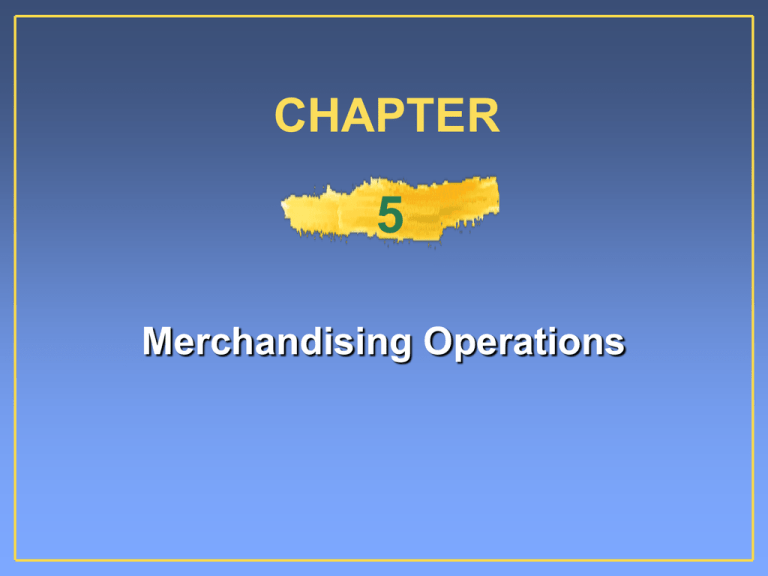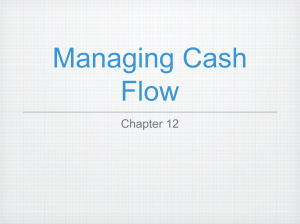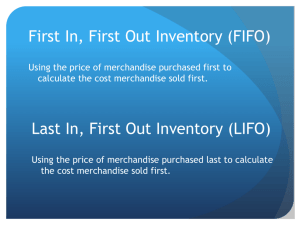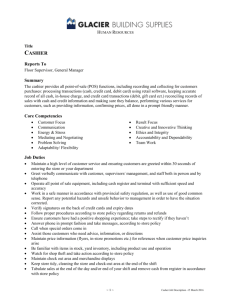Ch05
advertisement

CHAPTER 5 Merchandising Operations Differences Between Service and Merchandising Companies Service enterprises perform services as their primary source of revenue Merchandising companies buy and sell merchandise Merchandising Company Revenues and Expenses • Primary source of revenues is the sale of merchandise – Sales revenue • Expenses for a merchandising company are divided into two categories – Cost of goods sold – Operating expenses Earnings Process Measurement for Merchandiser Illustration 5-1 Inventory Systems • Merchandising entities may use either (or both) of the following inventory systems – Perpetual – Periodic Inventory Systems • The periodic inventory system is covered in Appendix 5A. • See slides later in this presentation on the periodic system. Perpetual Inventory • This type of inventory system constantly updates inventory for purchases and sales • When a perpetual system is used, it is still necessary to do a physical count at least once a year to adjust perpetual records to actual • This system is used for many types of products Cost of Merchandise Inventory • All costs of getting the inventory to the company and ready for sale • Only costs associated with merchandise purchased for resale, not assets acquired for use, such as supplies Merchandise Purchases On May 4, the company bought $ 3,800 worth of merchandise from PW Audio Supply, Inc. Merchandise Inventory May 4 3,800 GENERAL JOURNAL May 4 Accounts Payable May 4 3,800 Debit Credit Merchandise Inventory 3,800 Accounts Payable To record goods purchased on account 3,800 Freight Costs—On Incoming Inventory On May 4, the company paid $150 to have the merchandise inventory delivered to them. Merchandise Inventory Freight-Out Cash May 4 3,800 May 4 150 GENERAL JOURNAL May 4 Merchandise Inventory Cash To record payment of freight May 4 150 Debit Credit 150 150 Freight Costs—On Outgoing Inventory Or, assume that on May 4 the seller paid $150 to have merchandise inventory delivered to the buyer. Merchandise Inventory May 4 3,800 Freight-Out May 4 150 GENERAL JOURNAL May 4 Cash Freight-Out Cash To record payment of freight on goods sold May 4 150 Debit Credit 150 150 Purchases Returns and Allowances On May 8 the company returned $300 worth of merchandise to PW Audio Supply, Inc. Merchandise Inventory May 4 3,800 May 4 May 8 300 Accounts Payable May 8 300 May 4 3,800 150 GENERAL JOURNAL May 8 Accounts Payable Merchandise Inventory To record goods returned that were purchased on account Debit Credit 300 300 Purchase Discounts • Credit terms specify the amount of cash discount available to encourage early payment and the time period during which it is offered • 2/10, n/30 ( a 2% discount can be taken if the invoice is paid in 10 days, otherwise the total invoice amount is due in 30 days) Purchase Discounts Company purchased $3,800 of merchandise and returned $300. The credit terms are 2/10, n/30 and the invoice was paid within the discount period. Original invoice Less: Returns Amount due before discount 2% discount Net due $3,800 300 3,500 70 $3,430 Purchase Discounts Company purchased $3,800 of merchandise and returned $300. The credit terms are 2/10, n/30 and the invoice was paid within the discount period. Merchandise Inventory May 4 3,800 May 8 300 May 4 Accounts Payable May 8 Cash May 14 3,430 300 May 4 3,800 150 May 14 70 May 14 3,500 GENERAL JOURNAL May 14 Debit Accounts Payable 3,500 Cash Merchandise Inventory To record payment within discount period Credit 3,430 70 Sales Revenue—Perpetual System • Recorded when earned – Revenue recognition principle • Two entries are made for each sale – To record sale – To record cost of merchandise sold Sales Assume a cash sale of $2,200 for merchandise that cost $1,400 Cash Accounts Receivable May 4 2,200 Merchandise Inventory May 4 1,400 Sales May 4 2,200 Sales Returns & Allowances Cost of Goods Sold May 4 1,400 Sales Assume a sale of $3,800 on account for merchandise that cost $2,400 Cash Accounts Receivable Merchandise Inventory May 4 3,800 Sales May 4 3,800 Sales Returns & Allowances May 4 2,400 Cost of Goods Sold May 4 2,400 Sales Returns and Allowances • Contra revenue account to sales • Separate account used contrary to purchase returns and allowances • Used to show how much came in on returns and allowances • Excessive returns and allowances suggest – Errors in billing customers – Mistakes in delivery or shipment of goods Sales Returns and Allowances Flip side of purchase returns and allowance EXCEPT two entries are required: one to record return (at sale price) and one to restore goods to inventory, assuming goods resaleable (at cost) On seller’s books GENERAL JOURNAL May 8 Sales Returns and Allowance Accounts Receivable To record return of goods delivered to Sauk Stereo Merchandise Inventory Cost of Goods Sold To restore returns to inventory Debit Credit 300 300 140 140 Sales Discounts • Contra revenue account to sales • Separate account used contrary to purchase discounts • Used to disclose amount of cash discounts taken by customers Sales Discounts On buyer’s books General Journal May 14 Accounts Payable Cash Merchandise Inventory To record payment within discount period Debit 3,500 Credit 3,430 70 On seller’s books General Journal May 14 Cash Sales Discounts Accounts Receivable To record collection within discount period Debit 3,430 70 Credit 3,500 Two Forms of Statements of Earnings • Single-step statement of earnings • Multiple-step statement of earnings Single-Step Statement of Earnings Revenues Expenses Earnings before income taxes Income taxes Net earnings $10,000 2,000 8,000 1,000 $ 7,000 PW AUDIO SUPPLY, INC. Single-Step Statement of Earnings Year Ended December 31, 2004 Sales Interest revenue Gain on sale of equipment Total revenues Expenses Cost of goods sold Operating expenses Interest expense Casualty loss from vandalism Total expenses Earnings before income taxes Income tax expense Net earnings $460,000 3,000 600 $463,600 $316,000 114,000 1,800 200 432,000 31,600 10,100 $ 21,500 PW AUDIO SUPPLY, INC. Multiple-Step Statement of Earnings Year Ended December 31, 2004 Sales revenue Sales Less: Sales returns and allowances Sales discounts Net sales Cost of goods sold Gross profit Operating expenses Store salaries expense Advertising expense Amortization expense Freight-out Salaries expense Utilities expense Insurance expense Total operating expenses Earnings from operations $480,000 $12,000 8,000 20,000 460,000 316,000 144,000 $45,000 16,000 8,000 7,000 19,000 17,000 2,000 114,000 30,000 PW AUDIO SUPPLY, INC. Multiple-Step Statement of Earnings Year Ended December 31, 2004 Earnings from operations (continued) Other revenues Interest revenue Gain on sale of equipment Other expenses Interest expense Casualty loss from vandalism Earnings before income taxes Income tax expense Net earnings $30,000 $3,000 600 3,600 $1,800 200 2,000 1,600 31,600 10,100 $21,500 Evaluating Profitability • Gross profit margin • Profit margin Gross Profit Margin Gross Profit Margin = Gross Profit Net Sales Company’s gross profit expressed as a percentage Profit Margin Profit Margin = Net Earnings Net Sales Appendix 5A: Periodic System • Merchandising entities may use either (or both) of the following inventory systems – Perpetual – Periodic Periodic System • This type of inventory system does not keep an updated record of all goods bought, sold and on hand • In a periodic system, inventory is only counted once a year • This system is mostly used for inexpensive products Sales Revenues—Periodic System • Record when earned - revenue recognition principle • Only ONE entry is made for each sale in a periodic inventory system • NONE to record cost of goods sold as in a perpetual inventory system Sales Assume a sale of $3,800 on account Cash Accounts Receivable May 4 3,800 Sales May 4 3,800 Sales Returns & Allowances Merchandise Inventory X Cost of Goods Sold X Purchase of Merchandise • Perpetual inventory system – Merchandise Inventory-one account used to accumulate the cost of goods purchased • Periodic inventory system – Separate accounts used to accumulate the cost of goods purchased Normal Balances Cost of Goods Purchased Accounts Account Purchases Purchase Returns and Allowances Purchase Discounts Freight In Normal Balance Debit Credit Credit Debit Net Purchases Net purchases are gross purchases adjusted for returns and discounts Purchases Less: Purchase returns and allowances Purchase discounts Net purchases $325,000 $ 10,400 6,800 17,200 307,800 Cost of Goods Purchased Cost of goods purchased is net purchases plus freight-in Purchases Less: Purchase returns and allowances Purchase discounts Net purchases Add: Freight-in Cost of goods purchased $325,000 $ 10,400 6,800 17,200 307,800 12,200 320,000


